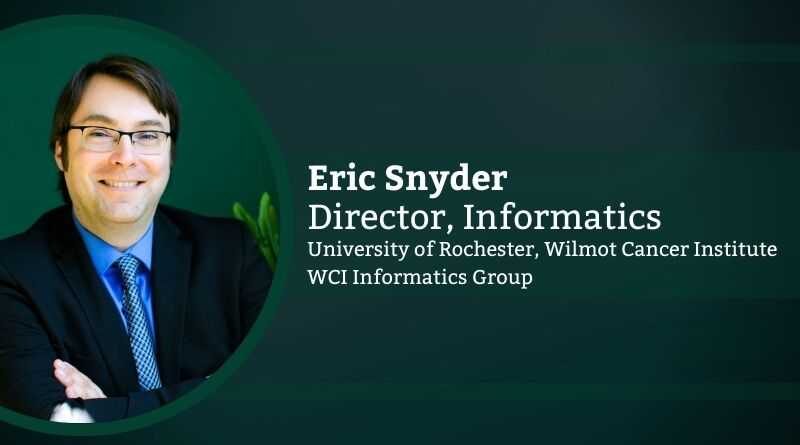Transforming Healthcare Information Technology – A Paradigm Shift
By Eric Snyder, Director, Informatics – University of Rochester, Wilmot Cancer Institute, WCI Informatics Group
While my entire career has been centered in the technology space, I’ve had the unique opportunity to switch industries multiple times, travel the nation as a technology implementation consultant, lead red teams in the cyber security space, and architect and develop solutions for a multitude of healthcare systems. These diverse experiences have provided me with a unique perspective and have allowed me to access an internal knowledge base while tackling the technical problems of today.
It is no secret that healthcare technology tends to lag far behind its industry counterparts. In the past, this gap was somewhat manageable, but during the pandemic, when the healthcare industry faced challenges in organizing integrated responses utilizing technology, it was extremely problematic, and as we move forward, this gap is growing. Worse yet, many in the healthcare technology space don’t possess the wide-ranging breadth of technical experience necessary to fully recognize the existence and gravity of this lag in technology. In the current age of extremely advanced technical professions including Cloud Computing, Machine Learning and AI, and other sophisticated sub specialties in the technology field, which could be harnessed in countless ways, we are falling behind, clinging to an outdated paradigm.
My dream is that we have systems and methodologies in place to seamlessly support clinicians at any point in the care cycle so they can consider technology a valuable tool and not a hindrance.
The Healthcare Technology Paradigm
Healthcare technology teams have traditionally consisted of highly skilled, dedicated individuals who often spent their entire career in the space and focused on data storage and support and configuration of purchased systems rather than innovation and new technology. This aligned with the medical care paradigm: “autonomous and highly trained doctors will collect and process all information necessary to care for each patient.” [1] As White stated in 2008, “the increasing requirements for knowledge by both patients and doctors; by the need to evaluate populations of patients inside and outside one’s practice, …, and by a seemingly insurmountable demand for chronic disease care,” drove the medical paradigm to shift to a heavy reliance on Healthcare Information Technology (HIT). [1] The methodologies and practices to manage and govern healthcare technology have not evolved to align with the evolution of medical care, and a new paradigm is necessary.
Altering the Paradigm
One common strategy has been the “fast follower” approach. An organization purchases solutions from industry innovators and technologists rather than funding in-house innovation. Healthcare technology groups typically purchase technology and relegate the maintenance of the hardware, configuration, and support of analytics for that technology to their existing technical staff. As a result, the expansive technical skill base and resources we see in the industry are not often present or valued in the same way, outsourced, or just misunderstood in general. While on the surface, this appears to be a cost-effective and resource-optimizing approach, it inevitably results in furthering the technical gap in healthcare.
The first paradigm shift needed in the healthcare technology space is to bring high technology expertise back in house. One of the common misconceptions about the fast following approach is that purchased technology and vendor solutions will be fully supported by the vendor or with minimal effort from in-house technical staff. In reality, however, skilled technical professionals and subject matter experts are integral to properly vetting vendor solutions, solving complex integration and implementation issues, and supporting the products.
Consider an extremely common technical problem in healthcare: A clinician submits a ticket to produce a mildly complex report that is unavailable in the vendor-designed system. Suppose a ticket has to be submitted to the vendor, or consultant (due to the lack of value placed on highly technical internal staff). In that case, the turnaround time is likely to be measured in dollars and months versus staff expertise and days. Due to technical debt limitations, there will always be products better purchased than developed in house, but for true innovation to occur, it has to come from within healthcare organizations, where the tacit expertise of the physicians, nurses, and staff can be leveraged. This can only occur if we staff our technology teams appropriately.
The next paradigm shift is to encourage in-house innovation and embrace cutting-edge technology development. While some of the large-scale systems are clearly better purchased from vendors, and the industry should continue to innovate on behalf of healthcare, it is equally important for each organization to consider healthcare innovation as a prime objective of technical teams. In the current paradigm, technical groups are focused on the day-to-day operations of a healthcare organization, essentially running the electronic health record and all the ancillary systems that support the operation. There also needs to be a significant segment of the organization dedicated to high technology and innovation. We in healthcare technology should be at the forefront of Machine Learning, Blockchain, AI, and Virtual Reality, etc. We should not be outsourcing these technical concepts to companies that do not have access to our tacit internal knowledge.
Moving Forward
I see signs of change. Some institutions have dedicated extensive funding to internal groups responsible for innovating in the Machine Learning, Blockchain, and AI spaces. While this encompasses only a few organizations so far, the change is positive, and I am beginning to see more adopting these thoughts. My dream is that we have systems and methodologies in place to seamlessly support clinicians at any point in the care cycle so they can consider technology a valuable tool and not a hindrance. We can accomplish this goal; we just have to re-imagine and re-orient how we handle healthcare technology for the future.
References [1] White RE. Health information technology will shift the medical care paradigm. J Gen Intern Med. 2008 Apr;23(4):495-9. doi: 10.1007/s11606-007-0394-y. PMID: 18373152; PMCID: PMC2359518.

